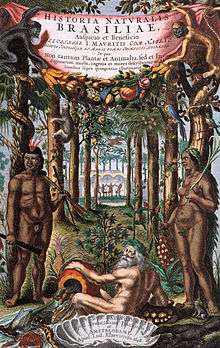Willem Piso
Willem Piso (in Dutch Willem Pies, in Latin Guilielmus Piso or Gulielmi Pisonis, also called Guilherme Piso in Portuguese) (1611 in Leiden – November 28, 1678 in Amsterdam) was a Dutch physician and naturalist who participated as an expedition doctor in Dutch Brazil from 1637 – 1644, sponsored by count Johan Maurits van Nassau-Siegen and the Dutch West India Company. Piso became one of the founders of tropical medicine. A minor planet, 11240 Piso, and the plant genus Pisonia are named for him.

Life and career

Piso was born in Leiden to church organist Hermann Pies and Cornelia van Liesvelt. He studied in Leiden and received a degree in medicine from Caen in 1633 and settled in Amsterdam as a doctor. In 1637, he was offered a position in the Dutch West India Company as a physician to Count Johan Maurits van Nassau-Siegen (1604-1679), governor of Dutch Brazil. He left for Brazil along with the astronomer Georg Markgraf or Georg Marcgrave (1610-1644)and the painters Albert Eckhout and Frans Post. There, he recommended the consumption of fresh fish, vegetables, and fruits after discovering that soldiers and seamen suffered from physical problems including night blindness resulting from malnutrition. Piso identified Brazilian lemons as being particularly effective in overcoming scurvy. In 1644, Piso returned along with the Count to the Netherlands. Piso lived in Leiden and then moved to Amsterdam, where he was a part of the scientific community. In 1655, he became inspector of the Amsterdam Medical College, and later its dean.[2]
Together with Georg Marcgrave, and originally published by Joannes de Laet, Piso wrote the Historia Naturalis Brasiliae (1648), an important early Western insight into Brazilian flora and fauna. He also published as part of this work four parts titled De medicina Brasiliense in which he examined tropical diseases and indigenous therapies (including the use of ipecacuanha-root and leaves of the jaborandi[3]), Piso collected plants and animals in Brazil. In 1658, he published another work, which is a second edition of the Historia titled De Indiae Utriusque re naturali et medica. He was the sole author of this and he is said to have tried to undermine Markgraf's work, and many careless errors, leading to criticism from Markgraf's brother and even Linnaeus.[4][5][6]
He is buried near Rembrandt in the Westerkerk in Amsterdam.
References
- Facsimile of original 1648 manuscript
- Van Andel, M. A. (1924). "Willem Piso, éen baanbreker der tropische geneeskunde" [Piso, a Pioneer of Tropical Medicine]. Nederlands Tijdschrift voor Geneeskunde (in Dutch). 68 (14): 1731–1746.
- Holmstedt, Bo; Wassén, S.Henry; Schultes, Richard Evans (1979). "Jaborandi: An interdisciplinary appraisal". Journal of Ethnopharmacology. 1 (1): 3–21. doi:10.1016/0378-8741(79)90014-X.
- Brienen, R.P. (2001). "Georg Marcgraf (1610 – c. 1644): A German Cartographer, Astronomer, and Naturalist-Illustrator in Colonial Dutch Brazil". Itinerario. 25 (1): 85–122. doi:10.1017/S0165115300005581. ISSN 0165-1153.
- Whitehead, P. J. P. (1979). "The biography of Georg Marcgraf (1610-1643/4) by his brother Christian, translated by James Petiver". Journal of the Society for the Bibliography of Natural History. 9 (3): 301–314. doi:10.3366/jsbnh.1979.9.3.301. ISSN 0037-9778.
- Whitehead, P. J. P. (1976). "The original drawings for the Historia naturalis Brasiliae of Piso and Marcgrave (1648)". Journal of the Society for the Bibliography of Natural History. 7 (4): 409–422. doi:10.3366/jsbnh.1976.7.4.409. ISSN 0037-9778.
- IPNI. Piso.